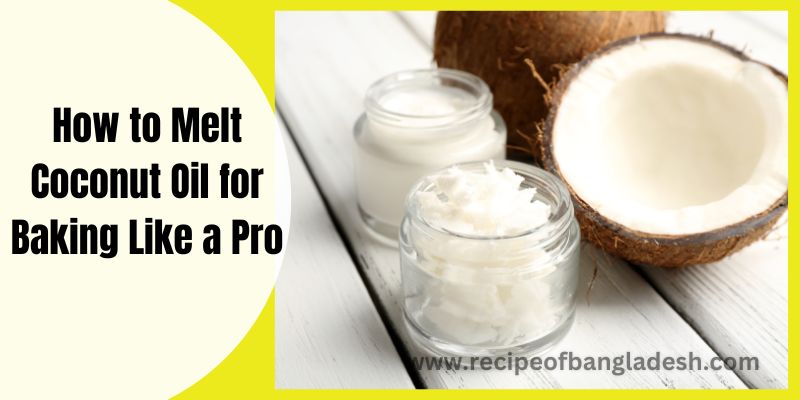Welcome to my guide on how to melt coconut oil for baking! If you’ve ever tried to bake with coconut oil, you know that it can be a bit tricky to work with. Unlike other oils, coconut oil solidifies at room temperature and needs to be melted in order to be properly incorporated into recipes.
But don’t worry – melting coconut oil is actually quite easy and only takes a few minutes. In this article, I’ll teach you through the process of melting coconut oil for baking, as well as provide some tips and tricks to make the process even easier.
Next, I’ll cover the different types of coconut oil available and which ones are best for baking. From virgin to refined, and solid to liquid, there are a few options to choose from. I’ll help you decide which one is right for your baking needs.
Finally, I’ll show you how to melt coconut oil using either a microwave or a double boiler. Both methods are quick and easy, so you can choose the one that works best for you.
By the end of this guide, you’ll be a pro at melting coconut oil for baking and be ready to tackle any recipe that calls for it. So let’s get started!

Why Melting Coconut Oil Is Important for Baking
First, let’s talk about why melting coconut oil is so important for baking. Because it solidifies at room temperature, coconut oil can be difficult to measure and mix into batter if it’s not properly melted. By melting the coconut oil first, you can ensure that it is evenly distributed throughout your recipe, giving you the best possible results.
Coconut Oil Solidifies at Room Temperature
One of the unique characteristics of coconut oil is that it solidifies at room temperature. This means that if you try to mix it into a recipe while it is in solid form, it can be difficult to measure and incorporate evenly. In order to properly use coconut oil in baking, it is important to melt it first.
Need to Melt It to Properly Incorporate It into Recipes
By melting the coconut oil, you can ensure that it is evenly distributed throughout your recipe. This will give you the best possible results and help to prevent any unevenness in the finished product. For example, if you are making a batch of cookies and some of the cookies have a higher concentration of coconut oil than others, it can result in uneven texture and flavor.
Therefore, in order to properly incorporate coconut oil into your baking recipes, it is important to melt it first. This will allow you to easily measure and mix the coconut oil into your batter or dough, resulting in a more consistent and successful final product.
Choosing The Right Coconut Oil
Virgin or Refined
When it comes to baking with coconut oil, there are a few different options to choose from. One important factor to consider is whether you want to use virgin or refined coconut oil.
Virgin coconut oil is made from fresh coconut and is considered to be more natural and unprocessed. It has a stronger coconut flavor and aroma, which can be desirable in some recipes but may be too overpowering in others.
Refined coconut oil, on the other hand, is made from dried coconut meat and undergoes a refining process to remove impurities. It has a more neutral flavor and aroma, making it a good choice for recipes where you don’t want the coconut flavor to be too prominent.
Solid or Liquid
In addition to choosing between virgin and refined coconut oil, you’ll also need to decide whether you want to use solid or liquid form. Coconut oil is sold in both solid and liquid form, and the type you choose will depend on your personal preference and the recipe you are using.
Solid coconut oil is easier to measure and can be melted quickly in the microwave or over low heat. Liquid coconut oil is already in a melted state and can be easier to pour and mix into recipes.
Both solid and liquid coconut oil can be used successfully in baking, so it’s up to you to decide which form works best for you and your recipe. My personal choice always virgin coconut oil for baking.
How to Melt Coconut Oil for Baking in Many Ways
There are two main way to melting coconut oil
- Natural way Using Sun
- Using Equipment
How to Coconut Oil Melting Using Sun?
Coconut oil can be melted using the sun by placing the jar or container of coconut oil in direct sunlight. Depending on the temperature and intensity of the sun, it can take anywhere from a few hours to a full day for the oil to fully melt. It is important to check on the oil regularly and stir it to ensure it melts evenly. If the weather is cool or overcast, the coconut oil may not melt at all, so it is best to do this method on a sunny day.
This is a very old and grandmother technique in Bangladesh and we are all very familiar with this process. We did that in our childhood with our grandmothers, especially in winter mornings.
Equipment Needed for Melting Coconut Oil
- Microwave
- Double boiler
- Stove
Melting Coconut Oil in The Microwave
One quick and easy way to melt coconut oil for baking is to use the microwave. Here’s how to do it:
- Measure out the desired amount of coconut oil. Coconut oil can be measured in either solid or liquid form, so you can use either a measuring cup or a kitchen scale to get the correct amount.
- Place the coconut oil in a microwave-safe dish. A small bowl or measuring cup works well for this purpose.
- Heat the coconut oil in short increments, stirring in between. Coconut oil melts quickly in the microwave, so you’ll only need to heat it for 15-30 seconds at a time. After each increment, remove the dish from the microwave and stir the coconut oil to ensure that it is melting evenly.
- Continue heating and stirring until the coconut oil is completely melted. Depending on the amount of coconut oil you are melting and the strength of your microwave, this may take a few rounds of heating. Just be sure to keep an eye on the coconut oil and stop heating as soon as it is fully melted to prevent it from overheating.
Once the coconut oil is melted, it is ready to use in your baking recipe. Just be sure to let it cool slightly before adding it to your batter or dough to prevent it from solidifying again.Top of Form
Melting Coconut Oil Using a Double Boiler
If you prefer to melt coconut oil over the stove, you can use a double boiler to do so. Here’s how:
- Fill the bottom pot of the double boiler with water and place it on the stove over medium-low heat. The water should be at a gentle simmer, not a rolling boil.
- Place the desired amount of coconut oil in the top pot of the double boiler. You can use either solid or liquid coconut oil for this method.
- Place the top pot of the double boiler on top of the bottom pot, making sure that the bottom pot is not so hot that it cooks the coconut oil.
- Allow the coconut oil to melt over the gentle heat of the double boiler. This may take a few minutes, depending on the amount of coconut oil you are melting.
- Once the coconut oil is fully melted, remove the top pot from the heat and use the melted coconut oil in your baking recipe as desired.
Using a double boiler to melt coconut oil allows you to control the temperature of the oil as it melts, helping to prevent it from overheating. Just be sure to keep an eye on the water in the bottom pot and refill it as needed to prevent it from boiling dry.
Melting Coconut Oil on the Stove
There are two main ways to melt coconut oil on the stove: directly and indirectly.
- Directly melting coconut oil on the stove:
- Place the jar or container of coconut oil on a stovetop burner set to low heat.
- Stir the oil occasionally to ensure that it melts evenly.
- Be careful not to overheat the oil, as this can cause it to smoke or burn.
- Indirectly melting coconut oil on the stove:
- Fill a pot with water and place it on the stove to boil.
- Once the water is boiling, reduce the heat to low and place a heatproof bowl containing the coconut oil on top of the pot.
- The heat from the boiling water will melt the coconut oil in the bowl.
- Stir the oil occasionally to ensure that it melts evenly.
It’s important to keep an eye on the oil while it is melting and to not let it overheat. Also, it’s recommended to use a thermometer to measure the temperature of the oil while it is melting, as overheating can cause it to lose some of its beneficial properties.
Tips and Tricks
Here are a few tips and tricks to help you get the most out of your melted coconut oil when baking:
How to Store Melted Coconut Oil
If you have leftover melted coconut oil after baking, it can be stored in the refrigerator for later use. Just be sure to transfer it to an airtight container and label it with the date. Melted coconut oil will solidify when chilled, so it will need to be remelted before using it again.
Using Melted Coconut Oil in Recipes
Melted coconut oil can be used in place of other liquid oils in most baking recipes. Just be sure to follow the recipe and use the correct amount of coconut oil as specified. If you are adapting a recipe that calls for a different type of oil, you may need to make some adjustments to the amounts or baking times to account for the different properties of coconut oil.
Overall, melted coconut oil is a versatile ingredient that can be used in a wide variety of baking recipes. Whether you are making cookies, cakes, or bread, it is a delicious and healthy option that is sure to impress. Just be sure to melt it properly and store it correctly to get the best results.
Conclusion
In conclusion, melting coconut oil is an important step in baking with this versatile ingredient. By melting the coconut oil first, you can ensure that it is evenly distributed throughout your recipe and give yourself the best chance of success.
You have learned the process of melting coconut oil using either a microwave or a double boiler, as well as that I provided some tips and tricks for storing and using melted coconut oil in your baking.
Whether you are a seasoned baker or just starting out, I hope that this guide has given you the confidence to try melting coconut oil at home. With a little bit of practice, you’ll be a pro at melting coconut oil for baking in no time!

Leave a Reply